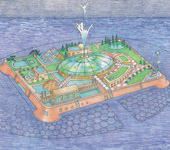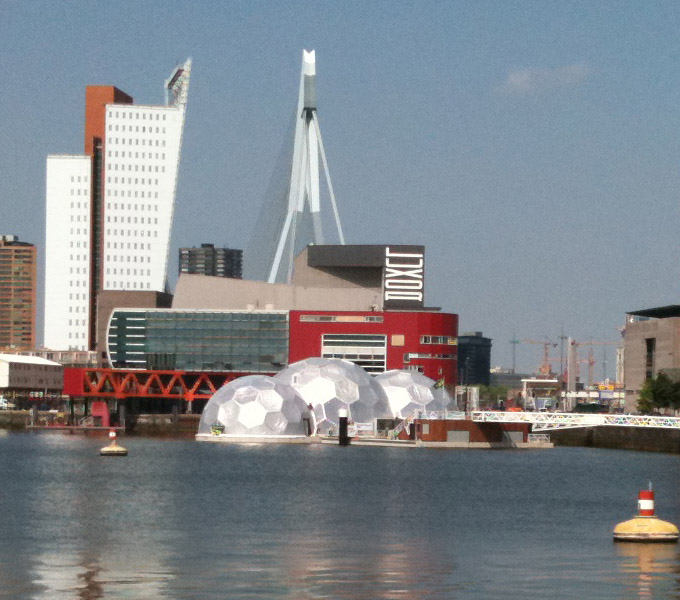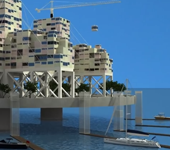ONE WORLD Magazine
 Journalist Hidde Jansen writes: Forget Mars, deserts or kilometer high apartment buildings, in the future we live at sea. If you ask the Dutch pioneers Frits Schoute and Rutger de Graaf, floating cities will be reality within twenty years. Read the full article (in Dutch) at www.oneworld.nl/water/klimaat-toekomst/kunnen-we-wonen-op-zee Click on “read more” for the English translation
Journalist Hidde Jansen writes: Forget Mars, deserts or kilometer high apartment buildings, in the future we live at sea. If you ask the Dutch pioneers Frits Schoute and Rutger de Graaf, floating cities will be reality within twenty years. Read the full article (in Dutch) at www.oneworld.nl/water/klimaat-toekomst/kunnen-we-wonen-op-zee Click on “read more” for the English translation
BACKGROUND –
Whoever enters the Floating Pavilion in Rotterdam Rijnhaven, does not realize immediately that the solid ground under your feet is gone. The more than 2 meters thick bottom is a sturdy combination of polystyrene (EPS) and concrete, and there is no swinging up and down. “Nevertheless, you are standing on the water,” says Rutger de Graaf of DeltaSync and Blue21, two companies specialized in floating urbanization.  “If you really look closely at the quay, you can observe that sometimes the pavilion is moving slightly.” The Floating Pavilion, looking from the outside like three merged floating footballs, has to convince the world of possibilities on the water, according to De Graaf. Because where else should we go, when in 2050 coastal metropolises bulge and we need to feed 9 billion people?
“If you really look closely at the quay, you can observe that sometimes the pavilion is moving slightly.” The Floating Pavilion, looking from the outside like three merged floating footballs, has to convince the world of possibilities on the water, according to De Graaf. Because where else should we go, when in 2050 coastal metropolises bulge and we need to feed 9 billion people?
From the drawing board …
With his thesis on ‘Making cities less vulnerable and more self-sufficient’ De Graaf got his PhD in 2005 with honors at TU Delft. Since then he researches with Deltasync all floating opportunities. “I calculated, based on the current global energy consumption and available space to live and grow crops, that we have a deficit of 22 million square kilometers of land in 2050. That’s twice the size of China!” Making less than 1 percent of the ocean surface livable and productive, could solve that problem. “In addition, a floating surface follows the rising sea-level.”
Another Dutchman preceded De Graaf in the late 90s at the drawing board. Frits Schoute was, in his own words, declared “crazy” by his wife when he retired as professor at TU Delft and decided to focus on living at sea. “But for me it was a quite logical idea. What do you have on shore? Scarcity of space, energy and water. Where do you have an abundance of that? On the sea, which covers 70 percent of the earth’s surface.”
On paper Schoute made the first sketches, where he focused on energy issues. “I looked at atlas maps of various major cities along the coast and mirrored them across the shoreline. So you get a perfect interplay: the surplus CO2 and nutrients from the industry on land can be used at sea. Carbon (C), for example, is taken up in algae cultivation, which forms a basis for fish farming and biofuel. Oxygen (O2) will be released in the air again. Energy is extracted from sunlight, water and wind. In the end a circular system arises, which prevents the depletion of resources as happens now on land.”
… To practice
The paths of the two pioneers crossed and many calculations, experiments and trips around the world followed. Materials were tested (“polystyrene in concrete floats fine”) maximum building heights estimated (“up to fifteen floors can withstand a hurricane”), breakwaters made (“to prevent seasickness and to generate energy from wave currents”), areas calculated (“a click system works best”) and international delegations convinced of the possibilities (“in New Orleans and Hong Kong they were very enthusiastic”). De Graaf speaks of a blue revolution: to make the transition on water from hunting and gathering to organized food production and urban development. “As happened 3000 years ago on land.”
Yet the practical implementation of the sea cities ideas of DeltaSync does yet not go beyond the Floating Pavilion and six floating eco-houses in Delft. That’s according to De Graaf because it is not easy to convince investors and politicians on a large scale. “On paper, everything is possible. Technical innovation is found in every area of sustainability, ranging from electric transportation to food production. But we need money to take the next step, such as a floating residential area. That could convince the politicians of the feasibility, so you can proceed and attract new investors.”
Political freedom at sea
To reinforce the blue revolution, the founders of Deltasync started in 2014 with Blue21: an international network with architects, engineers, biotechnologists and developers. Another boost for the realization of the first maritime city probably comes from the US Silicon Valley. There, software engineers Patri Friedman and Wayne Gramlich cooperate since 2008 with The Seasteading Institute on floating startup cities, so called seasteads.

Big difference with the Dutch concept: the Americans operate from the idea to create political liberty, regardless of rules and systems that apply on the mainland. People can develop their own forms of government. Moreover, such a maritime city would not come to the coast, but on the high seas, outside territorial waters. Although Peter Thiel, co-founder of PayPal, has invested a sloppy $ 500,000 in development, also seasteads did not yet progress beyond many calculations, drawings, theories and experiments.
Schoute and De Graaf have mixed feelings about the American counterpart. Schoute: “I am sorry that they have a political motive, which is not my way of thinking. But it can serve as a spin-off. In the US much more venture capital is available to show what is possible”. De Graaf adds: “There are not many organizations that are dealing with it in a serious manner, so you should optimally use the scarce knowledge. They are very ambitious and want have their Floating City already completed in 2020. ”
Practical implementation
The hurdles still to be taken, do in no way hinder De Graaf to think further about the actual realization of a floating city. Who are the sailor-man and -women of the first hour? “It is not intended to attract only yuppies and the rich. That may happen in the beginning, but that’s not a problem. Also cell phones were initially used by a small group. Thus, they could be developed further so that eventually the price was greatly reduced. Basically it is a new district with different types of housing: social housing, apartments, detached houses. A lot of water is slightly cheaper than land, buildings again more expensive. Net you arrive at about the same prize. ”
You can arrange everything anew in a floating city and there are endless possibilities for sustainability.
And how do you ensure that it is the countries with the heaviest population pressure, often not the richest countries, can expand on sea? “A floating city is not a blueprint. The whole point is that per location one considers how to build in an adaptive way. This way you save a lot of expenses and you can expand each coastal city with floating districts, also in Asia and Africa. Cities such as Hong Kong, Jakarta and Lagos are almost bursting, so there I see the best opportunities to start internationally.”
Seeing is believing
As far as the Netherlands is concerned, a maritime city in the eyes of De Graaf provides an opportunity for people “who want to live sustainably, but are hampered by the country.” “The existing infrastructure makes sustainability on the mainland often too expensive or there are obstacles, for example, to have your own drinking water purification. In a floating city you can organize everything anew and there are endless possibilities. A study we commissioned shows that one third of the Dutch embrace the idea to live on the water.”
Twenty years and the first floating city will be a fact, persist Schoute and De Graaf. The Floating Pavilion plays an important role. De Graaf: “That starts convincing people about what is possible on the water. Seeing is believing.” For now the first maritime city floats only around in thoughts and scale models, and the loose floating puzzle pieces, like the ultimate city, must yet still be clicked together.
Comment